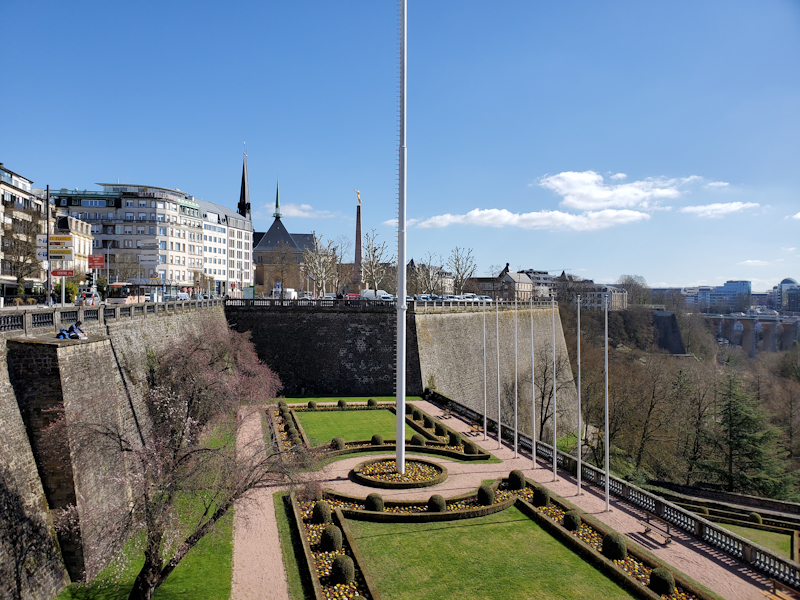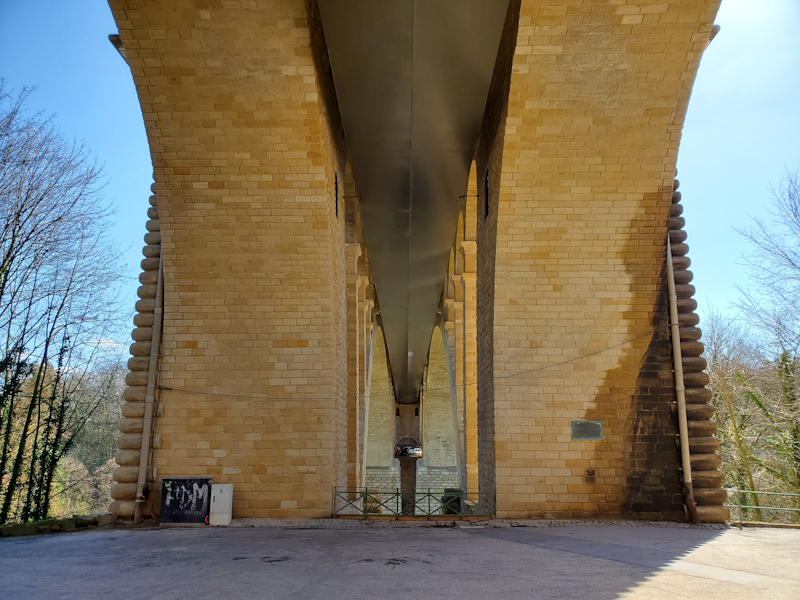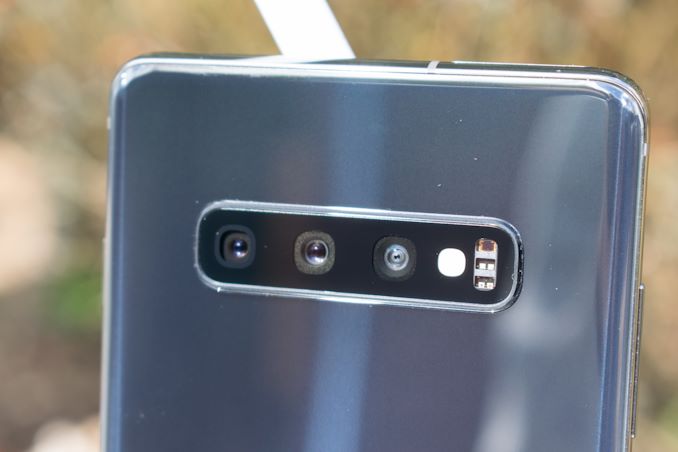The Samsung Galaxy S10+ Snapdragon & Exynos Review: Almost Perfect, Yet So Flawed
by Andrei Frumusanu on March 29, 2019 9:00 AM ESTDaylight Evaluation: Triple Camera For Scenic Shots
Besides the display of the Galaxy S10, the biggest new features of this year’s flagship is the camera setup. The S10 is Samsung’s first flagship device with a triple-camera setup, and also the first Samsung flagship a wide-angle camera module.
The main camera module in terms of specifications is similar to last year’s: A 12.2MP sensor taking still pictures up to a resolution of 4032 x 3024. The focal length is 26mm, or a FoV of 77° and the lens mechanism comes with Samsung’s signature dual-aperture mode with f/1.5 and f/2.4 apertures. The sensor has 1.4µm pixels with full dual-pixel PDAF. Even though Samsung doesn’t advertise it, the sensor actually did see a change this year. S.LSI actually seemingly has won the design contract for all main sensors on the S10, coming with a new “S5K2L4” sensor shared among both Snapdragon and S.LSI variants.
The telephoto lens also remains a similar 12MP unit with 1.0µ pixels with a 52mm focal length or 45° FoV which acts as a 2x telephoto lens and an aperture of f/2.2. I wasn’t able find the sensor name for this module.
Finally the new wide-angle module is a 16MP shooter with 1.0µm pixels and a 13mm / 123° wide angle view on an f/2.4 aperture lens. The notable part about this unit is that it lacks any autofocus mechanism and also doesn’t come with OIS like the other two rear camera modules. The sensor here is again supplied by SLSI and is the “S5K3P9”.
Sony apparently just won dual-sourcing of the main front 10MP sensor in the form of the IMX374 which is shared with S.LSI’s S5K3J1. Oddly enough the secondary front camera / depth sensor is reported as 6.5MP which doesn’t match Samsung’s official specifications of it being 8MP.
This year I had a hunch about the camera performance between the Snapdragon and Exynos units and actually made the effort to wait for my camera evaluation until I got both units in-house (Plus the weather was bad for a week!). In the past there were some slight discrepancies between the two chipset variants but never something to really worry about. As we’ll see for the Galaxy S10 – this is absolutely not the case and the Snapdragon 855 Galaxy S10+ versus the Exynos Galaxy S10+ will be showcasing some drastic differences in camera performance.

[ Galaxy S10+ Snapdragon ] - [ Galaxy S10+ Exynos ]
[ Galaxy Note9 (E) ] - [ Galaxy S9+ (S) ] - [ Galaxy S8 ]
[ iPhone XS ] - [ iPhone X ] - [ LG V40 ] - [ OnePlus 6T ]
[ Pixel 3 ] - [ View20 ] - [ Mate 20Pro ]
In the main module we’re seeing some slight exposure differences between the two units; the Snapdragon is able to maintain more contrast in the picture as the Exynos’ HDR flatten things a bit too far. The Snapdragon’s exposure is nearly identical to the S9+ and at first glance it’s hard to see any difference.
Opening up the full resolution images however shows a definitive change in details, with the Galaxy S10 actually see a degradation compared to the S9+. This is particularly visible in the trees on the right part of the scene where the S10 blurs the branches a lot more. The same degradation also happens against the Note9 which in these shots is the Exynos variant, so I don’t think it’s something related to the new S.LSI sensor vs the S9+’s Sony sensor.
Switching over the zoom and wide angle lenses, the difference between the Snapdragon and Exynos S10 is massive. What especially is striking is the colour rendition between both phones. The Snapdragon is a lot more saturated with stronger contrasts in textures. In the zoom shot the Exynos, while maybe being more natural, looks just bland and lacking saturation compared to the Snapdragon’s more colourful rendition with a ton more texture contrast. In the wide-angle shot, the Exynos also vastly loses out in detail in the trees in the right part of the scene, ending up as a smudged result while the Snapdragon maintain the branch detail.
Comparing the wide-angle shots against the competition, only real competitor is the Mate 20 Pro as the LG V40 continues to apply LG’s pointless blurring noise reduction which results in a water-colour effect.

[ Galaxy S10+ Snapdragon ] - [ Galaxy S10+ Exynos ]
[ Galaxy Note9 (E) ] - [ Galaxy S9+ (S) ] - [ Galaxy S8 ]
[ iPhone XS ] - [ iPhone X ] - [ LG V40 ] - [ OnePlus 6T ]
[ Pixel 3 ] - [ View20 ] - [ Mate 20Pro ]
In the next shot we again see big differences in the HDR between the two phones. The Snapdragon unit has a lot more colour and contrast. There’s some odd effect going on with the detail of the gravel in the Snapdragon as the Exynos looks more natural, however in other parts of the scene detail definitely goes to the Snapdragon unit. The Exynos S10 is definitely a downgrade compared to the S9+.
The main competitions to the S10’s are the iPhone XS and V40’s main cameras. Comparing the XS picture, it’s obvious to see that the S10 applies a very large amount of sharpening which also results in a lot of halo artefacts around contrasted edges. This is one aspect in which the Exynos S10 seems to do better as its sharpening looks less aggressive, and thus for example the gravel looks better in this variant of the S10.
In the wide-angle shot we see similar results: The Qualcomm unit has massively better shadows and maintaining detail in the foliage in the scene. The Mate 20 Pro would have been a contender, however it missed the mark in terms of colour temperature, and the LG V40’s detail processing shoots itself in the foot as it for example just washes away the gravel.

[ Galaxy S10+ Snapdragon ] - [ Galaxy S10+ Exynos ]
[ Galaxy Note9 (E) ] - [ Galaxy S9+ (S) ] - [ Galaxy S8 ]
[ iPhone XS ] - [ iPhone X ] - [ LG V40 ] - [ OnePlus 6T ] - [ Pixel 3 ]
[ View20 ] - [ Mate 20Pro ]
Under the bridge HDR is again extensively used. The Qualcomm variant is able to achieve yet again more texture contrast and thus the bricks are more defined. To be noted is that both units had the same exposure time and ISO. The Snapdragon is a bit too colourful here with the sandstone while the Exynos is too bland.
In the wide angle, one would have thought the phones reversed as it’s the Exynos providing a more contrastful image and bringing out the textures. The Snapdragon is a lot more sharp as maintains the tree branches much better.
The Mate 20 Pro’s wide angle shot is a bit darker however it handily beats out the S10+ in terms of textures and detail. The V40 yet again almost completely blurs out the bricks in this shots in some spots so let’s just ignore it going forward.

[ Galaxy S10+ Snapdragon ] - [ Galaxy S10+ Exynos ]
[ Galaxy Note9 (E) ] - [ Galaxy S9+ (S) ] - [ Galaxy S8 ]
[ iPhone XS ] - [ iPhone X ] - [ LG V40 ] - [ OnePlus 6T ]
[ Pixel 3 ] - [ View20 ] - [ Mate 20Pro ]
In the city shot, the Exynos slightly flattens highlights too much and the building’s sunlit façade is toned down too much, the Snapdragon is doing better in maintaining the natural brightness. The Snapdragon did have a longer exposure however the main differences area in the processing.
On the wide-angle, the Exynos has more contrast, however it’s the bad kind of contrast due to lower dynamic range. The shadows in the scene lack definition as seen in the balconies, and again there’s such a big difference in detail retention between the two that I’m starting to wonder if there’s anything wrong with the optics on the Exynos, however we see this happening even in the centre of the image as well.
The Mate 20 Pro’s wide angle here is still clearly better than the S10 as it provides my dynamic range as well as a lot sharper details and textures.

[ Galaxy S10+ Snapdragon ] - [ Galaxy S10+ Exynos ]
[ Galaxy Note9 (E) ] - [ Galaxy S9+ (S) ] - [ Galaxy S8 ]
[ iPhone XS ] - [ iPhone X ] - [ LG V40 ]
[ OnePlus 6T ] - [ Pixel 3 ]
[ View20 ] - [ Mate 20Pro ]
This is a good shot to compare main, zoom and wide angle lenses and really showcases the advantages of having three camera modules.
As the scene has less HDR processing in general, the differences in exposure between the two S10s are less pronounced as in the previous shots. But even here the Snapdragon has some advantages such as the detail retention on the left tree.
In the wide angle shot the Exynos has significantly more noise in the blue sky even though both sensors captured at the same ISO and exposure length.

[ Galaxy S10+ Snapdragon ] - [ Galaxy S10+ Exynos ]
[ Galaxy Note9 (E) ] - [ Galaxy S9+ (S) ] - [ Galaxy S8 ]
[ iPhone XS ] - [ iPhone X ] - [ LG V40 ]
[ OnePlus 6T ] - [ Pixel 3 ]
[ View20 ] - [ Mate 20Pro ]
I the last scenic shot the composition between both S10’s is very similar however we see much better shadow detail in the low left on the Snapdragon unit. Throughout the picture the Snapdragon is also sharper although it does look like it might be a post-processing effect, even if it is I find it overall positive for the result.
The S9+ with the Sony sensor I think still provides the best natural sharpness and would choose that aspect over the S10’s result, even though the S10 has better dynamic range exposure.
On the wide angle, we see the Snapdragon have lighter shadows however the Exynos brings out more textures on the same spots. This shot also makes me think again there’s something wrong with the optics on the Exynos variants as details off-centre are just blurry and typical of lens issues we’ve seen in problematic smartphones over the years.











229 Comments
View All Comments
TechieSandy - Tuesday, April 2, 2019 - link
The difference in the Dynamic Range between the Snapdragon and the Exynos variant may have less to do with processing than the triggering by the camera. In one of the pics the Exynos proxessor has better details in the shadows and more dynamic range.In this photo:
https://images.anandtech.com/galleries/6981/S10PS_...
It may be something triggering the HDR algorithm. It may have to do with it.
Andrei Frumusanu - Friday, April 5, 2019 - link
That image you linked is the Snapdragon - check the difference in detail in the marble for example.urbanman2004 - Tuesday, April 2, 2019 - link
No wonder people are holding onto their phones at the most for 4 years as indicated by this article after seeing those prices. After selling my Galaxy S7, never again will I find myself being held captive from the ever tightening stranglehold made by SamsungKishoreshack - Tuesday, April 2, 2019 - link
Excellent review by Andreithis is even better than what Brian Klug used to do
your analysis is good & conclusion are spot on
I think you missed to test the GPS on both phones
which would make it a complete review
Andrei Frumusanu - Friday, April 5, 2019 - link
GPS part taken note of, I'll see what can be done in the future.nyonya - Wednesday, April 3, 2019 - link
Will the test results be added to Bench soon? Also, any guesses as to the battery life of the (Snapdragon) S10e? There's finally a small flagship phone and I'll probably upgrade to it. And agreed on the power button location, it's stupidly high on all the S10 variants.ElFenix - Wednesday, April 3, 2019 - link
45° FoV corresponds with a 52 mm lens on a 35 mm camera, which most people would consider 'normal' rather than 'telephoto.' 77° FoV corresponds with a 27 mm lens on a 35 mm camera, which most people would consider 'wide angle.' 123° FoV corresponds with a 12 mm lens on a 35 mm camera, which most people would consider 'super wide angle.'so this phone doens't have a telephoto camera in the traditional sense. only normal, wide, and super-wide.
s.yu - Friday, April 5, 2019 - link
Indeed it is and is what many have been complaining about, the terminology issue of phone cameras.US3R13 - Sunday, April 7, 2019 - link
I have a question in regard to the camera output of the Exynos model.Does the different we saw in the review only occur in the JPG or even if we shoot raw the difference still exists?
Thanks
zoamster - Wednesday, April 10, 2019 - link
This review was a real real treat.I have been waiting for this review ever since the devices launched and have checked the website more than 20 times. No review can be better than this and I hope the authors keep doing the excellent work.
I wish samsung starts selling snapdragon Soc phones in India(which i know they won't) and stop making those shitty ass exynos processors and start including hifi dac as lg does. Maybe improve the camera software department as pixel's or apple's.
It seriously feels bad that you spend a fortune to buy trash.
One question- Will the unlocked SD variant work fine in India?
PS- Thank you for make this excellent review and I hope to see more in future.